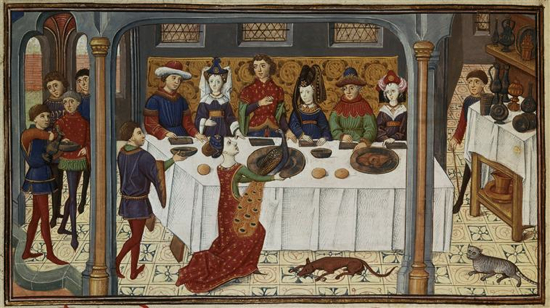“Lords, Ladies and Honored guests…

…will you now please direct your attention to the center of the gallery where we shall present tonight’s entremets for your amusement. We shall begin with an assortment of porridges flavored with pepper and cloves and colored with saffron. These are followed by three platters of duck innards boiled in ginger broth, adorned with pickled quinces in the shape of the Sardinian royal crest.
Following closely behind is a display of roasted spring hares stuffed with fried marinated sweetbreads and arranged as though they were still frolicking merrily on the sunny plains of Beauce. And what would our display be without fowl? Fix your gaze upon the center aisle where a bevy of swans now approaches, roasted and stuffed back into their original plumage, wings held aloft. Finishing the procession is an assortment of brightly colored eggs made entirely of roast birds, followed by a menagerie of exotic birds made entirely of roast eggs.
Next is a dramatic depiction of the death of Geoffrey, Duke of Brittany, here represented by a boiled capon clad in armor being trampled upon by his jousting steed, a roast suckling pig. After that an all-vegetable likeness of Duke Odo of Aquitaine, a reproduction of Agde Cathedral made entirely of boiled snails and frog’s legs and a giant mince pie from which will emerge a dwarf, two score live partridges and a monkey named Pug.
Lastly, my Lords and Ladies, our pièce de résistance, a twelve-foot, all-pastry model of the Hanging Gardens of Babylon featuring a working spiced wine fountain, acrobats, candied boar’s heads and cooked, fire-breathing peacocks. We trust that our little display amuses.”
Actually it’s not easy to satire Medieval entremets, or “subtleties” as they were known in English courts. These were the crazily opulent, sometimes-edible, sometimes-not-so-edible novelty dishes that were served at grand banquets as what you might call an “interlude”, or perhaps more accurately an “intermission”, since the word “entrement” is actually derived from the Latin word “intromissum” which means, roughly, “something stuffed into something else”.
Grand feasts needed these sorts of amusing interruptions since they went on for hours and the menus were repetitive: lots of roasted dishes, especially meats. Entremets were a way to literally “spice things up” with a little flavor, color and maybe even entertainment value. While the tradition goes back as far as Rome, it wasn’t until the High Middle Ages that entremets got really out of hand and became full pageants in addition to parades of culinary oddities. By the time they went out of style in the 1700’s, entrements featured huge sets and mechanical devices and culminated in plays, musical performances and acrobatic displays like the so-called “alamain leap” in which a jester would come running in, spring over the heads of the guests and land in a giant custard pie.
I bring all this up because this is the tradition from which the thing we now know as croquembouche arises: the grand entremet. Granted you don’t set one on fire or release live birds from it (though in truth I’d be open to either one of those this week) but there’s no question that it’s designed to be a spectacle — a pièce montée as entremets came to be known prior to the French Revolution. The most famous practitioner of these elaborate centerpiece was one Antonin Carême, about whom I shall have more to say later.
You could use flash paper for your mold. It would make for quite a presentation. 🙂
Now THERE’S a dude that’s thinkin’!
Ooooh I’m a little more than obsessed with historical cooking! I’m currently consumed with daydreams of medieval wooden gingerbread forms and elaborate Victorian jelly molds. I’m not sure if I’m more delighted by the actual dishes or with the extraordinay tools used to make them! I’m sure you know them, but these are my favourite stalking grounds for all things ancient food related.
http://www.godecookery.com
http://foodhistorjottings.blogspot.com
http://www.historicfood.com/RecipesIndex.htm
http://recipes.medievalcookery.com
Very cool, Gretchen! Thanks!
– Joe
But let’s take it up a notch. I’m thinking that if the choux happened to be prepped much like in the (I hope I did that coding correctly, not my strong point), but if there was a way to have that flat-top of caramel be somewhat concave… a little high-octane spirit dripped in, add flame, whoof. A spectacle like none other! Flambeau Croquembouche!
You are thinking BIG Roger! Who knows what the possibilities are?
– Joe
The nursery rhyme, 4 and 20 blackbirds is said to be the report of an actual dish served to the king, a pie with 24 live birds under the crust! It as not to be eaten but as a joke, entertainment. I never read how they got the dang birds out of the dinning hall after & would rather not imagine.
I too understand that the nursery rhyme comes from a real event. Would have liked to have been there!
– Joe